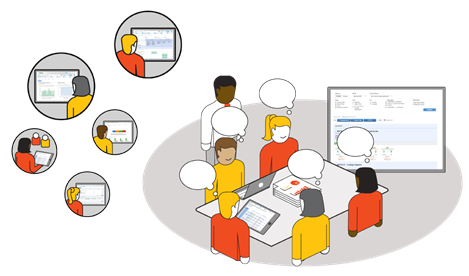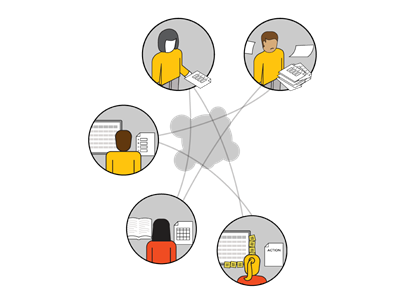
Software was a blessing that has become a burden. Large portions of institutional budgets are spent on software licensing fees. Departments, divisions, schools, and campuses use redundant and overlapping solutions, and often the data housed in disparate systems do not flow between them.
In 2021, The Chronicle of Higher Education surveyed more than 600 senior administrators from colleges and universities. The effort included interviews with presidents, chief information officers, and other institutional leaders. When asked what challenges might slow investments in technology, more than half of respondents (56 percent) said “faculty reluctance” would be a factor. Nearly half (49 percent) were concerned about training the campus community in academic technologies. Other challenges included measuring outcomes (35 percent) and calculating the benefits (27 percent) of investments in technology.
Susan Grajek, Vice President of EDUCAUSE, stated in the article that university leaders today “understand that data governance and data integrations are critical if we’re actually going to put data to work” in such applications as understanding student progress and helping learners succeed (Pelletier, 2021, p. 15).
Lack of Data Linkage Between Systems Increases Burden on Campus
Administrative staff and faculty in departments must spend time collecting and analyzing data. This valuable time that should be spent on research, student meetings, or other crucial work gets wasted on mundane activities.
Nowhere is this redundancy more obvious on campus than in assessment activity. Colleges must assess learning outcomes and rubrics, assessment scales and scores, actions and resources, and goals and objectives. As if that were not enough, coordinators and administrators must duplicate their efforts (e.g., enter results in both a learning management system and an assessment solution). Duplication of data entry creates several problems, not least of all the capacity for human error.
Mapping student learning outcomes to each institutional level is incredibly complex. Campuses need outcomes to map to student, course, program, and institutional levels seamlessly. The intricacies of program mappings intensify as institutions add new campuses, programs, and off-campus experiences.
Additionally, the meaning of “integration” varies by audience. Integrating the entire data ecosystem on campus is a massive undertaking. Sometimes a complete integration is unnecessary—often colleges discover they do not need every data point to connect.
Siloed data sources and overlapping software impact institutions financially and, again, augments the propensity for human error. Worst of all, higher education professionals are now conditioned for long project timelines.
Asking the Right Questions; Identifying Ideals
Institutions can start with the following questions to evaluate legacy systems:
- What do ideal assessment reports look like on campus?
- Which assessment data should be visible to which audience?
- Which data points need to connect to improve our culture of assessment?
- Which manual assessment processes are currently using the most institutional resources?
- How could we repurpose said institutional resources with the right integrations?
Hundreds of other questions will flow from this initial set, but these provide a framework to begin. As an institution approaches this conversation, certain ideals begin to emerge:
Integrations Should Scale
An integrated solution should allow an institution to scaffold learning outcomes to create a meaningful flow of data from a single assessment. Many assessment solutions force campuses to assess at the course, program, and institutional levels to get data for multiple dimensions. A good integration ensures that data points in an assessment score entered by a faculty member into one system automatically populate in a connected system. No more duplication.
Integrations Should Increase Accuracy
Automation of assessment processes ensures the veracity of data. When systems are set up properly, the institution will receive consistent real-time results. This ensures that campus leaders have visibility into how programs and service areas are performing. Additionally, it reduces the dependency on one-time reports from institutional research. Given the general backlog with those departments, results can often be out-of-date by the time the data gets analyzed. A modern cloud-based solution will have accurate real-time reports for consumption by appropriate audiences.
Integrations Should Save Time and Money
The most valuable asset at any college is its human capital. A truly integrated assessment system allows campuses to repurpose human work into areas of strategic importance. Many institutions also find they are able to reduce their spending on software license fees by removing redundant systems.

Changing the Status Quo and Integration Innovation
Despite the fact that assessment management systems should fully integrate with other campus systems (e.g., LMS, SIS), they often do not. Furthermore, while technology providers should have resources to help institutions implement integrations, many do not.
It is time to connect campus systems to allow for visibility into assessment data. It is time for assessment data to become actionable—closing equity gaps and improving student success. It is time for integration innovation.
eLumen helps institutions connect what’s possible. Colleges can streamline operational processes by breaking down silos and redundant systems to achieve institutional objectives.
Want to learn more? Watch this video to see how our partner institution, San Antonio College, evolved through the use of the eLumen software tool. Contact eLumen today to start the journey toward purposeful integrations.
Reference
Pelletier, S. (2021). Strategic tech decisions during the pandemic. The Chronicle of Higher Education. https://d1y8sb8igg2f8e.cloudfront.net/StrategicTechResearchBrief.CHE.pdf












